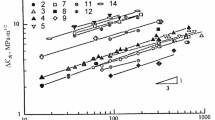Abstract
A thermal activation model of the endurance limit is proposed in the present study. It can quantitatively explain the effects of temperature and frequency on the endurance limit of metals at or below room temperature. Theoretical analysis indicates that the endurance limit, σac, which is considered as a parameter characterizing the resistance of metals to cyclic microplastic deformation, has the same thermally activated nature as the plastic flow stress has and it can be resolved into two independent components: the long-range internal stress (the athermal component), μ(εapc), and the short-range effective stress (the thermal component), σa *(T, εp). The former is considered as a material constant insensitive to temperature and strain rate (or frequency). The latter, the temperature- and strain rate-dependent part of the endurance limit, is approximately identical with the effective stress component of plastic flow stress (or cyclic yielding stress). In light of the thermal activation model, the temperature and strain-rate dependence of monotonic and cyclic flow stresses in a low alloy steel (16Mn) and a precipitation-hardening aluminum alloy (LY12CZ) were experimentally investigated. The results indicate that the effective stress components of monotonic and cyclic flow stresses are identical, if the temperature and strain rate are held unchanged, and that both of them are approximately independent of the magnitude of plastic strain. On the basis of the thermal activation model, an expression predicting the endurance limit below room temperature is offered. The predicted values of the endurance limit agree with the test data of steels and aluminum alloys available in literature.
Similar content being viewed by others
References
R.I. Stephens:Fatigue at Low Temperatures, ASTM STP 857, ASTM, Philadelphia, PA, 1985.
J. Schijve:Prediction on Fatigue, JSME Int. J., Series I, 1991, vol. 34(3), pp. 269–80.
B. Lü: Ph.D. Thesis, Northwestern Polytechnical University, Xi'an, People's Republic of China, 1991.
H.-P. Lieurade:Estimation des characteristiques de résistance et d'endurance en fatigue, La fatigue des materiaux et des structures, C. Bathias and J.P. Bailon, eds., L'Univeristé de Montreal, Montreal, PQ, Canada, 1981, pp. 31–71.
Handbook on Materials for Superconducting Machinery, Metal and Ceramic Information Center, 1977.
R.D. McCammon and H.W. Rosenberg:Proc. R. Soc. London A, 1957, vol. 242 (1229), pp. 203–09.
X. Zheng and G. Zhang:J. Northwestern Polytechnical University, (in Chinese), 1984, vol. 2 (2), pp. 223–26.
M. Klesnil and P. Lukas:Fatigue of Metallic Materials, Elsevier Scientific Publishing Company, Amsterdam, Holland, 1980, p. 159.
X. Zheng, C. Lin, H. Jiang, and B. LÜ:Acta Aeronautica Sinica, 1992, in press.
G. Schock:Thermodynamics and Thermal Activation of Dislocation, Dislocation in Solid, F.R.N. Nabarro, ed., North- Holland Publishing Company, Amsterdam, 1980, pp. 64–164.
J.M.C. Li:Can. J. Phys., 1967, vol. 45, pp. 493–500.
J. Polak and M. Klesnil:Mater. Sci. Eng., 1976, vol. 26, pp. 157–66.
X. Zheng and B. Lü:Int. J. Fatigue, 1987, vol. 9 (2), pp. 169–74.
X. Zheng and B. Lü:Fatigue Formula under Cyclic Strain, Fatigue and Fracture Mechanics, Proc. 1st Int. Conf. on Localized Damage Computer Aided Assessment and Control, Portsmouth, United Kingdom, 1990, pp. 175–84.
D.T. Read:Mechanical Properties, Materials at Low Temperatures, R.P. Reed and A.F. Clark, eds., ASM, Metals Park, OH, 1983, pp. 237–68.
I. Gupta and J.M.C. Li:Metall. Trans., 1970, vol. 1, pp. 2323–30.
J.I. Michlak:Acta Metall., 1965, vol. 13, pp. 213–22.
Z.S. Basinski and S.G. Basinksi:Acta Metall., 1989, vol. 37, pp. 3255–62.
Z.S. Basinski, A.S. Korbel, and S.J. Basinski:Acta Metall., 1980, vol. 28, pp. 191–207.
P. Lukas and L. Kunz:Mater. Sci. Eng., 1988, vol. 103A, pp. 233–39.
B.I. Verkin, N.M. Grinberg, V.A. Serdyuk, and L.F. Yokovenko:Mater. Sci. Eng., 1983, vol. 48 (2), pp. 145–68.
H. Abdel-Raouf and A. Plumtree:Metall. Trans., 1971, vol. 2, pp. 1863–67.
N.E. Frost, K.J. Mash, and L.P. Pook:Metal Fatigue, Oxford Press, Oxford, United Kingdom, 1975.
Y.T. Chen, D.G. Attridge, and W.W. Gerbrich:Acta Metall., 1980, vol. 29, pp. 1171–85.
H. Jiang: Master's Thesis, Northwestern Polytechnical University, Xi'an, People's Republic of China, 1989.
J. Lin: Ph.D. Thesis, Xi'an Jiaotong University, People's Republic of China, 1989.
J.W. Sprenek, M.G. Fotana, and H.E. Brooke:Trans. ASM, 1951, vol. 43, pp. 547–70.
P.L. Teed:The Properties of Materials at Low Temperatures, Champton & Hall, London, 1950.
J.L. Zambow and M.G. Fotana:Trans. ASM, 1949, vol. 41, pp. 480–518.
F.R. Schwartzberg, T.F. Kiefier, and R.D. Keys:Adv. Cryog. Eng., 1964, vol. 10, pp. 1–13.
F.W. Demoney and G.L. WolfenAdv. Cryog. Eng., 1960, vol. 16, pp. 590–603.
Author information
Authors and Affiliations
Rights and permissions
About this article
Cite this article
Lü, B., Zheng, X. Thermal activation model of endurance limit. Metall Trans A 23, 2597–2605 (1992). https://doi.org/10.1007/BF02658063
Received:
Published:
Issue Date:
DOI: https://doi.org/10.1007/BF02658063




